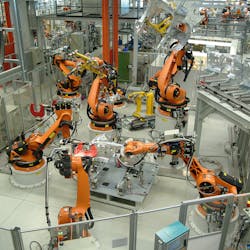Future is now for robots, says president of Association for Advancing Automation
Plastics Machinery & Manufacturing is focusing on automation in March. Come back to plasticsmachinerymanufacturing.com and check out this month's print issue for more.
By Karen Hanna
Forget just pulling parts out of a mold. Robots of the future — the near future — will be serving us food and changing our tires, too.
That’s the potential Jeff Burnstein, president of the Association for Advancing Automation (A3), sees as he reflects over a career spanning nearly 40 years working with automation.
With robots increasingly taking over dirty, dull and dangerous jobs, people with a wider range of skill sets and physical capabilities will be able to enter industries that were once fairly homogenous. That means companies that are now hurting for talent will be free to widen their search.
“I think that the jobs of the future, first of all, I think there’ll be more of them. And I think there’ll be better and safer and higher-paying jobs. And I think we’re already seeing that,” said Burnstein, who takes issue with the notion that robots will take jobs.
“Let’s say about 2010 to 2018, that was the biggest era of expansion in robot use in U.S. history. So, we had 180,000 robots installed during that period in the United States. What happened to unemployment during that period? It fell from about 10 percent to about 3.5 percent. Now, does that sound like a job-killer to you?” he asked. “It looks to me like anything but a job-killer. We were becoming more productive.”
Initially, shortcomings in automation dampened a swell of enthusiasm in the early days of the technologies, said Burnstein, who has been involved with A3 and its associated groups — the Robotic Industries Association, AIA - Advancing Vision + Imaging and the Motion Control & Motor Association — since the early 1980s. But now, he said, automation is levelling up.
As an example of robots’ potential, he pointed to RoboTire, a startup developing automation for tire-change outlets.
“Their dream is developing a four-robot system to change tires at places like Discount Tire, who happens to be an investor, I believe, in the company,” he said. “The motivation here is that there’s a shortage of workers to work in these tire stores, that, if you want your tires changed, you’re going to have to wait a long time. ... This four-robot systems can do it in 15 minutes, it can do it more accurately, you’ll have all kinds of data on it.”
Along with businesses and consumers, workers stand to benefit, too.
“The other thing this allows you to do is to get more people into that business because right now, if you want to be somebody who works changing tires all day, you’ve probably got to be pretty big and strong to be constantly lifting tires. Now, if the job is to oversee the robots doing it, and run it from your cell phone, a different skill set is needed; different types of people could do it,” he said.
Robots will continue their advance into all kinds of work settings, he predicted.
“The trend toward companies in every industry moving to investigate and adopt automation, that seems to be accelerating quite a bit, regardless of industry, driven certainly in large part by labor shortages, and the uncertainty of where we’re headed with a pandemic,” Burnstein said.
Karen Hanna, senior staff reporter
Contact:
Association for Advancing Automation, Ann Arbor, Mich., 734-994-6088, www.automate.org
More on automation
Automation is on every manufacturer’s mind these days, or it should be. There’s more to our Cover Story:
• Processors hustling to add more robots to their mix. https://plasticsmachinerymanufacturing.com/21258332
• Worker shortage, advancements in technology fuel cobot sales. https://plasticsmachinerymanufacturing.com/21257916
• Veteran manufacturer of EAOT says automation is now accessible to anyone. https://plasticsmachinerymanufacturing.com/21256653
• A project manager or integrator can help make your robot installation a success. https://plasticsmachinerymanufacturing.com/21258310
• Robots don’t kill jobs; they free humans to move into better ones, experts say. https://plasticsmachinerymanufacturing.com/21258504
• A cobot industry analyst predicts strong growth will continue. https://plasticsmachinerymanufacturing.com/21258134
• Rapid Robotics’ subscriptions offer an affordable way to start automating your plant. https://plasticsmachinerymanufacturing.com/21258285
• Yaskawa enhances features on two new products. https://plasticsmachinerymanufacturing.com/21256712
• Epson’s easy programming lowers the barrier to entry. https://plasticsmachinerymanufacturing.com/21258503
• Three case studies show cobots’ versatility. https://plasticsmachinerymanufacturing.com/21258453
About the Author
Karen Hanna
Senior Staff Reporter
Senior Staff Reporter Karen Hanna covers injection molding, molds and tooling, processors, workforce and other topics, and writes features including In Other Words and Problem Solved for Plastics Machinery & Manufacturing, Plastics Recycling and The Journal of Blow Molding. She has more than 15 years of experience in daily and magazine journalism.

